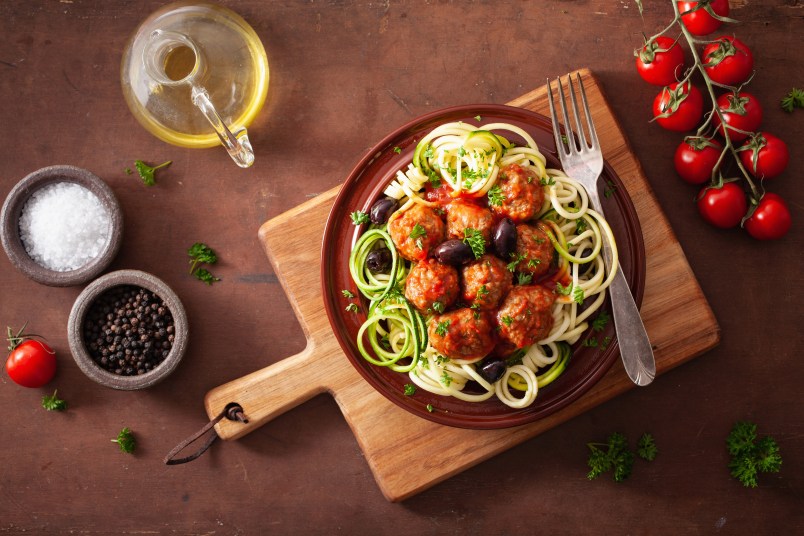Heal Your Gut, Lose Weight, and Prevent Alzheimer’s With the Microbiome Diet

Whether or not you’re trying to lose weight, you’ve probably heard a thing or two about the microbiome, the bacterial environment of the gut consisting of trillions of bacteria that influence our health. While some of these bacteria can cause disease, many of them promote a healthy body by boosting our natural defenses.
A healthy microbiome has been linked to a decreased risk of cognitive impairment (conditions like Alzheimer’s and dementia), mental health issues like depression and anxiety, and even cardiovascular disease. Unfortunately, our eating habits don’t always support a healthy microbiome, but with the help of the microbiome diet, we can bring everything back into balance, fight disease, and shed unwanted pounds — naturally!
The Microbiome Diet ($12.81, Amazon) was developed by Raphael Kellman, MD, a board-certified physician who specializes in gut health. Dr. Kellman’s four-phase plan is based on the idea that eating the right foods will restore balance to the gut biome and help you lose weight and achieve better health. During phase one (which lasts 21 days), you follow a meal plan based on “the four R’s:” Remove (as in toxins, chemicals, preservatives, hormones, and other inflammation-causing foods), Repair (the gut-lining, using plant-based food options and supplements), Replace (replacing stomach acids and digestive enzymes in the diet with herbs, spices, and supplements), and Reinoculate (repopulating the gut with good bacteria using prebiotic and probiotic-rich foods and supplements).
Foods you can eat during this phase include probiotic-rich foods like fermented veggies, fermented dairy (like yogurt and kefir), prebiotic-rich foods like asparagus, leeks, garlic, onions, carrots, jicama, and radishes, chickpeas and lentils, non-processed meats like free-range chicken and wild-caught salmon, other non-starchy fruits and vegetables like avocado and apples, and spices like cinnamon and turmeric.
So what exactly can’t you eat? Here’s a list of foods to totally eliminate during phase one:
- Processed or packaged foods
- High-fructose corn syrup
- Trans and hydrogenated fats
- Dried or canned fruits
- Juices
- Gluten
- All grains
- Corn and cornstarch
- All sugars and sweeteners, natural or artificial, except Lakanto
- All dairy products except butter and ghee (clarified
- All legumes except chickpeas and lentils
- butter)
- Eggs
- Soy products
- Processed meats
- High-mercury fish like tuna
- Peanuts and peanut butter
- Canola oil or cottonseed oil
- Potatoes, sweet potatoes, or yams
During this phase, Dr. Kellman recommends taking supplements to help you remove toxins from the digestive tract, with several options to choose from like garlic, berberine, and oregano oil. He also suggests replacing stomach acid with apple cider vinegar by diluting one to four teaspoons of ACV mixed with six tablespoons of water and drinking just before meals. It’s also recommended that you use gut-healing supplements like probiotics, vitamin D, zinc, and more during this phase.
Once 21 days are up, you’re ready to start the metabolic reset phase. This part of the diet lasts 28 days, and you can now introduce some of the banned foods from phase one back into your diet, like eggs, grains, starchy fruit and vegetables, and legumes. You’re still encouraged to stick to the approved food list from phase one for 90 percent of the time, but four meals per week can be “cheat meals” including foods that aren’t recommended. By this time, it’s believed that your gut has undergone significant healing and that your metabolism will experience a boost.
The next and final phase is where the real lifestyle change comes into play. This phase doesn’t have a recommended time to follow it, but you’re encouraged to stick to certain habits that will maintain your gut health for the long haul. To keep a healthy gut, Dr. Kellman suggests that you keep your diet in compliance with the microbiome diet food list from phase one for 70 percent of the time. This means that you can afford one “cheat” meal per day, though it’s highly suggested that refined carbs and sugars continue to be avoided. That’s it!
So there you have it. This microbiome diet plan might just be your missing key to weight loss. But even if you’re not trying to lose weight, eating a diet rich in more fruits and veggies while limiting things like complex carbs and sugar is sure to boost your health in more ways than one.
Wishing you a healthy, happy road to gut recovery!
This article originally appeared on our sister site, First for Women.
More From Woman’s World
Chris Hemsworth’s Trainer Says You Only Need to Workout for 5 Minutes a Day to Get Results
This French Soup Will Help You Lose Weight Fast — And It Tastes Delicious












